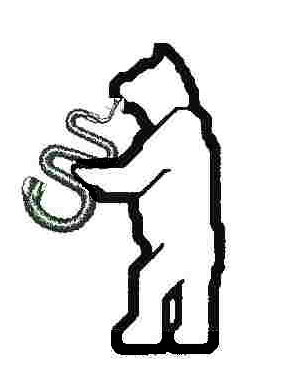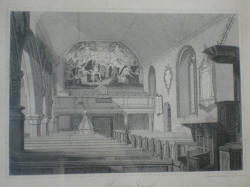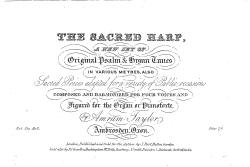 |
Amram Taylor |
||||||||||
|
Amram Taylor (1802 - 1855)At the end of 2005 Edwin and I were beginning to look at the music we might produce for the second Mid-Shires’ Quires’ Day, taking place on 29 April. For anyone who hasn’t heard of it before, it’s an event to promote interest in the work of regional composers, particularly those previously undiscovered. We had pieces by Thomas Jarman of Clipstone, Northamptonshire, and Joseph Watts, the psalmody compiler and composer from Fenny Compton in Warwickshire, items from the collections made by Matthew Wilkins of Great Milton in Oxfordshire, but were on the hunt for something new to everybody, including us. If you put ‘Psalms’ or ‘Psalmody’ in the on-line Integrated Catalogue of the British Library, for the former you get over 600 entries, for the latter, several thousand entries. Ploughing through them, usually there is not much more than a name, a title and mostly, but not always, an approximate year of publication. I came across some names previously unknown to either of us, and post-Hymn Tune Index period, and a couple in particular stood out. One was F.W. Saunders, but his story – a sorry tale – can wait. The one that really stood out for me was AMRAM TAYLOR. We had never heard of an Amram before, but we have since found the name means ‘beloved of the most high, friend of Jehovah’, and the Biblical Amram was the father of Moses, Miriam and Aaron. He lived to be 137 years of age. Whoever Amram Taylor was, he produced a collection of psalm tunes called The Sacred Harp, which, according to the Integrated Catalogue, was thought to be published in 1842. At that point I moved to the International Genealogical Index website run by the Mormons. Entering ‘Amram Taylor’ in the search produced only three, who were – it afterwards transpired – father, son and nephew. All three were baptised in Ambrosden Church, near Bicester in Oxfordshire, less than 10 miles from where we lived. The hunt was on. Amram Taylor, baptised in St Mary the Virgin Church, Ambrosden, on 27 June 1802, was probably the youngest son, and last child, of John Taylor and Anne Golder, who had married in the same church in 1786. Two of his older brothers, William and Barnabus, were living in the village in the 1841 census, and were Agricultural Labourers. At that time, of the village’s population of 205, 30 were called Taylor and were all related by blood and/or by marriage. Amram was a shoemaker, and in 1841, then aged 39, was living next door to a Francis Blewitt, aged 60, also a shoemaker, perhaps he was his apprentice. In 1824, Amram had married Martha Penn, and by 1841 they had five children, Amram, Caleb, Daniel, Elizabeth, and Mary. Amram Junior died early in 1851 and his father survived him for only another four years. A sixth child, Andrew, was born six months after the 1841 census. Amram senior’s death was registered in Bicester in the June quarter of 1855, and by 1861 his widow and sons Caleb and Andrew had moved to Headington, on the eastern outskirts of Oxford. Martha Taylor defined herself as a shoemaker’s widow, and the boys as ‘cordwainers’. In 1842 Amram Taylor had published a collection of 61 of his own compositions, in a book entitled The Sacred Harp. (The 'Sacred Harp' was a term then used to describe religious music of or for the human voice.) It was printed and sold in London, but copies were also sold in Bicester, Buckingham, and Banbury. The Sacred Harp was a subscription edition, that is, funds for the publication were gathered in advance from those whose names and addresses would subsequently be listed at the start of the book. It was supported by the Viscount Dryden of Canons Ashby in Northamptonshire, and his brother, the Vicar of Ambrosden, Rev. L. Dryden, descendants of the family of the poet, John Dryden. Subscriptions also came from other clergy within a 10 mile radius of Ambrosden. With less than a handful of deviations, the demography of the subscription list – which totals 79 individuals – is remarkable in that it follows today’s route of the M40, approximately 10 miles either side, starting at Waterperry near Junction 8 and concluding at Junction 12, about 6 miles from Southam. The largest grouping of subscribers was in Bicester, ranging from a baker to an attorney, and there were four from Marsh Gibbon, just over the border into Buckinghamshire, only 4 miles away from Ambrosden, and itself a source of a manuscript of church music dating from the early nineteenth century. Many subscribers were ordinary artisans and agricultural labourers, including members of the extended Taylor family. Thomas Hardy in his novels refers to rural church music being performed from a ‘West Gallery’. During the Commonwealth period, most church organs were destroyed. Following the Restoration, a gradual introduction of musical accompaniment to worship, in the form of instrumental bands, necessitated the designation of an area within the church for the purpose. To that very end, many churches had erected a gallery on the west wall, opposite the altar. The church of St Mary the Virgin, Ambrosden, had a West Gallery, erected in 1763 ‘for the choir’ according to the Victoria County History. In Ambrosden church today there is a print, showing the gallery, which was published in 1812. The photograph reproduced below was taken by Edwin.
The gallery was a big one, with 31 seats, and it is possible to make out what looks like a music stand at the front, in the middle. The gallery was taken down during church ‘modernisation’ in 1867. Behind it was an elaborate ‘Day of Resurrection’ oil painting on the upper back wall. In the middle of the twentieth century the painting was deemed to have no artistic merit, and according to the Victoria County History in 1951 it was destroyed by order of the Parochial Church Council. Ambrosden church had a band. This is known from receipts, now held in the Oxfordshire County Record Office and used by the Church Wardens to compile their accounts in the latter end of the 18th century. There is mention of the payment of costs in 1781 associated with the ‘Enstruments’, including houtboys, (a variant spelling of ‘oboe’), a new crook for ‘the bassoon’, and the purchase of reeds. There is also a reference to a ‘clarionett’. Mr John Heritage, the Vicar’s Church Warden, paid a ‘William Green’ two guineas to ‘teach the singers’ in the same year. William Green, who signed the receipt with an X (his mark), may be the man baptised at Ambrosden in 1748, but he is otherwise a mystery. The longevity of the reign of the church band is as yet undiscovered, but at the moment there appears to be no written mention of an organ earlier than 1909. Given the existence of a church band in the last quarter of the 18th century, it is reasonable to ask for whom Amram was composing. As the title page of The Sacred Harp shows, his music is harmonised for piano or organ accompaniment, but it seems impossible – at present – to establish whether the tunes would have had an airing in the church with a band. The titles of the pieces – only a handful appear with words to sing – Mount Elim, Mount Gilead, Mount Ebal, Gihon, and Eden, for example, suggest Old Testament influences. Amram was not enamoured of the minor key, only two pieces contain sections in a minor mode, including his own setting, ‘Victory’, of Pope’s Ode, (‘Vital spark of heavenly flame’), and more than two thirds are in what are termed flat keys, i.e. F, B flat or E flat. At the beginning of the twenty-first century it is difficult to contemplate how a shoemaker could have acquired the basic skill of harmony and counterpoint to compose over 60 pieces of sacred music in what was then only a small village, admittedly but some 9 miles from a seat of musical learning in Oxford. Was he self-taught? Did some benefactor fund his musical education at an earlier age? There are lots of questions still requiring answers. Salvation, one of Amram’s compositions, was included in the second Mid-Shires’ Quires Day of regional West Gallery music, in Byfield, Northants, on 29 April 2006, and on May Day afternoon we paid a visit to Ambrosden. The church was locked, and in Edwin’s endeavours to locate the keyholder, he came across the leader of the Worship Group Band – Lisa Holmes. Lisa received the news of a home-grown composer with great excitement and enthusiasm, and we have since learned of the existence not only of Amram’s own copy of his book, and but a further three manuscript collections of church music within the village. Ambrosden celebrated its 900th anniversary this year, and as a result of our happy meeting with Lisa, together with Immanuel’s Ground and members of the West Gallery Music Association from other parts of the country, we provided a period costumed quire and band to perform two of Amram’s compositions [Salvation and Conclusion (midi file)} in a celebratory church service on 11 June, in the presence of the Bishop of Dorchester and the Lord Lieutenant of the County of Oxfordshire, Hugh Brunner. We and our friends in the WGMA, were thrilled to be able to return the music of what may be Ambrosden’s only composer to its rightful place in the heart of worship in the village. The discovery of manuscript sources of church music in the region continues. In July 2006 we were contacted by a couple who had purchased a manuscript at a village fete, in Buckland, Oxon. This fascinating snapshot of sacred church music came from Lower Heyford, only 10 miles west of Ambrosden, and less than 15 miles from Marsh Gibbon. Comparison of the contents of all three manuscripts will give us valuable insight into the choral and instrumental repertoire of some of the south Midlands parish churches up to the middle of the nineteenth century, a veritable late-Georgian top of the ecclesiastical pops! Compositions by the Canterbury born composer, Thomas Clark, a shoemaker like Amram Taylor, figure in all three sources and indicate the wide transmission of pieces from his many printed books. Much more research work remains to be done, of course, so watch this space!
|


